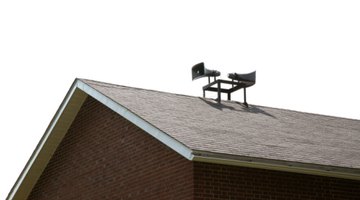Types of Fascia Wood
Fascia is an old term that backs to ancient times, often describing the ornate decorative stone work installed at the edge of a roof. Today in modern wood-frame housing, the fascia tends to describe the piece of trim that is installed on the end of the rafters just under the bottom edge of the shingles.

In many modern homes, the fascia board supports a gutter system that directs water runoff away from the side of the building.
Softwoods
Most commonly, softwoods such as Douglas fir and white or Ponderosa pine are deployed as fascia boards to cover the ends of the roof rafters and support a gutter system. These woods need to be thoroughly painted before installation with both a penetrating primer and a resilient, weatherproof topcoat. Once put in place, the painted wood adds a decorative element to the structure. For best results, these woods should be knot-free.
Water-Resistant Woods
Several woods are naturally water-resistant and as a consequence they are sometimes installed as the fascia on a one- or two-story residential building. Western red cedar, bald cypress, redwood and Eastern red cedar are some of the North American forest products frequently used. Because of their natural resistance to water and insects, these fascia woods are left in their natural state, with perhaps only a clear preservative added to the wood for protection.
Southern Yellow Pine
Southern yellow pine actually refers to as many as four different species of Southern pines used in the house-building industry. The wood of the longleaf, shortleaf, slash and loblolly pine can be used as fascia boards when painted, but most often the planks are subjected to the pressure-treatment process. Although treated with very toxic chemicals, pressure-treated pine makes for a durable fascia board that will not rot easily. Arsenic compounds, which are very toxic, were banned as of 2004 for wood intended for residential building projects. They have been replaced by alkaline copper quaternary (ACQ) and copper azole (CA).
Composite Trim
A more recent development is composite trim boards, especially manufactured for use in places that receive a lot of exposure to moisture and the elements. These boards are manufactured from a combination of wood fiber, plastic and a preservative. Usually one side is smooth and painted while the other face has a simulated wood grain, and they come in a variety of widths. These boards are able to resist water rot, fungi and decay without the use of extreme chemicals.
References
Writer Bio
Henri Bauholz is a professional writer covering a variety of topics, including hiking, camping, foreign travel and nature. He has written travel articles for several online publications and his travels have taken him all over the world, from Mexico to Latin America and across the Atlantic to Europe.
Photo Credits
- Jupiterimages/Photos.com/Getty Images
- Jupiterimages/Photos.com/Getty Images
More Articles



